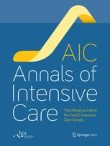The performance of severity-of-illness scores varies in different scenarios and must be validated prior of being used in a specific settings and geographic regions. Moreover, models’ calibration may deteriorat...
Authors:
Giulliana Martines Moralez, Ligia Sarmet Cunha Farah Rabello, Thiago Costa Lisboa, Mariza da Fonte Andrade Lima, Rodrigo Marques Hatum, Fernando Vinicius Cesar De Marco, Alessandra Alves, Jorge Eduardo da Silva Soares Pinto, Hélia Beatriz Nunes de Araújo, Grazielle Viana Ramos, Aline Reis Silva, Guilherme Côrtes Fernandes, Guilherme Brenande Alves Faria, Ciro Leite Mendes, Roberto Álvaro Ramos Filho, Valdênia Pereira de Souza…
Citation:
Annals of Intensive Care
2017
7:53
Content type: Research
Published on: 18 May 2017
